These jellyfish have pinhole sized-holes all around:
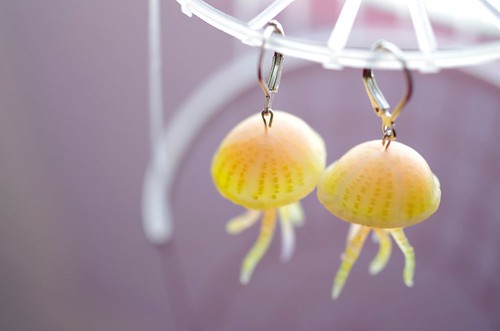
This is a variation of the Stroppel cane. The internal walls are about half a millimeter thick:
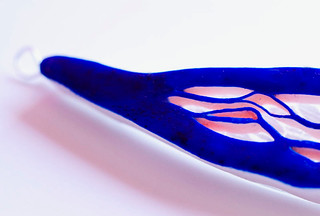
These cane slices have a single larger hole:
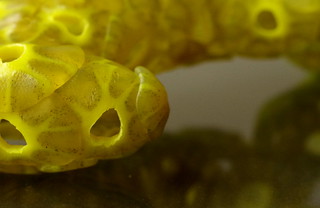
Or you can introduce "bubbles" of various sizes:
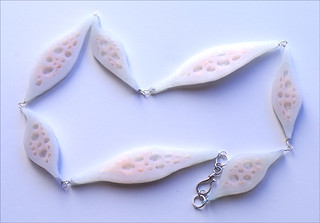
Disclaimer: I have had no problems baking playdoh at the temperatures at which polymer clay is normally baked. However, I do not know how it behaves at higher temperatures, or when baked for a very long time (more than an hour or two). Use caution like you would for any inclusion material.
I created holes within the cane by introducing cylinders of the commercially available playdoh children clay when I was building a cane, instead of polymer clay. The technique is based on the technique well known in the polymer circles of playdoh packing by Idit Zoota and Yonat Dascalu (where the water-soluble clay is on the outside of the cane to help you reduce irregularly shaped canes),
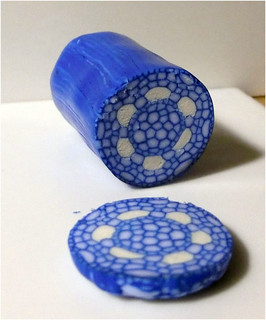
In the present case, the water-soluble playdoh is inside the cane, and preserves negative spaces even during cane reduction.


The holes can be used as a design element, or filled with liquid clay, paint...

A few considerations:
- Playdoh can be baked with the clay, and is removed completely by immersion after baking with no risk of destroying the cane. It might be removed before baking for some clays that stand water better (Kato and Premo).

-The more complex and large the playdoh inclusions are, the longer the soaking and elimination takes (the shell beads are the worst, for obvious reasons). Do not hesitate to use multiple baths and tools (toothbrush, tooth picks, etc) to help the water-soluble clay out.
- There are volume changes during drying (and baking, as baking dries partially the water-soluble clay). The water-soluble clay contracts visibly, but generally detaches enough from the polymer clay frame that it does not destroy the shape. You have to factor this in planning the piece.
- Remains of playdoh trapped in the clay do not actually pose too much structural integrity problems, although they are best avoided. While it is removable, it bonds enough to the clay that the whole remains relatively strong. I would not use scrap clay containing playdoh though, except for a few applications like the playdoh wood cane.
- Although I have used some canes of this type after several days, I would not recommend it. This child's clay is air drying. Canes are best used fast, or packed well in plastic to limit evaporation. Some leaching of the polymer clay may occur in both cases, and change the solidity of the clay. Again, best make the canes shortly before baking.
- Colors sometimes transfer to the polymer clay. If this is not what you are looking for, use a color a playdoh close to the one of your project, or white. Although this can make for cool effects too.
- The water soluble clay absorbs paint (acrylic, oil, inks) better than polymer clay. Beware of remains if you do antiquing.
Replacement clay: I have been looking for a replacement, home made clay, because I have trouble buying white playdoh only.
Cold porcelain does not work, because it contains oil and is therefore difficult to soak away. Salt dough is too rough.
Cornstarch and baking soda dough (recipe can be found easily through search, for instance on Instructables) is promising, although I have not tested it fully.
Linked posts:
Playdoh faux wood cane

Hollow beads using water-soluble child clay

Shell beads tutorial

I believe in sharing. I have learned most of what I know about polymer clay, and many other subjects, from the web, so giving back seems the right thing to do.
You are very welcome to use these techniques, and even sell the result. However, I would much appreciate a mention and a link if you use these techniques.
And I would love to see anything you have done with this...
Aucun commentaire:
Enregistrer un commentaire